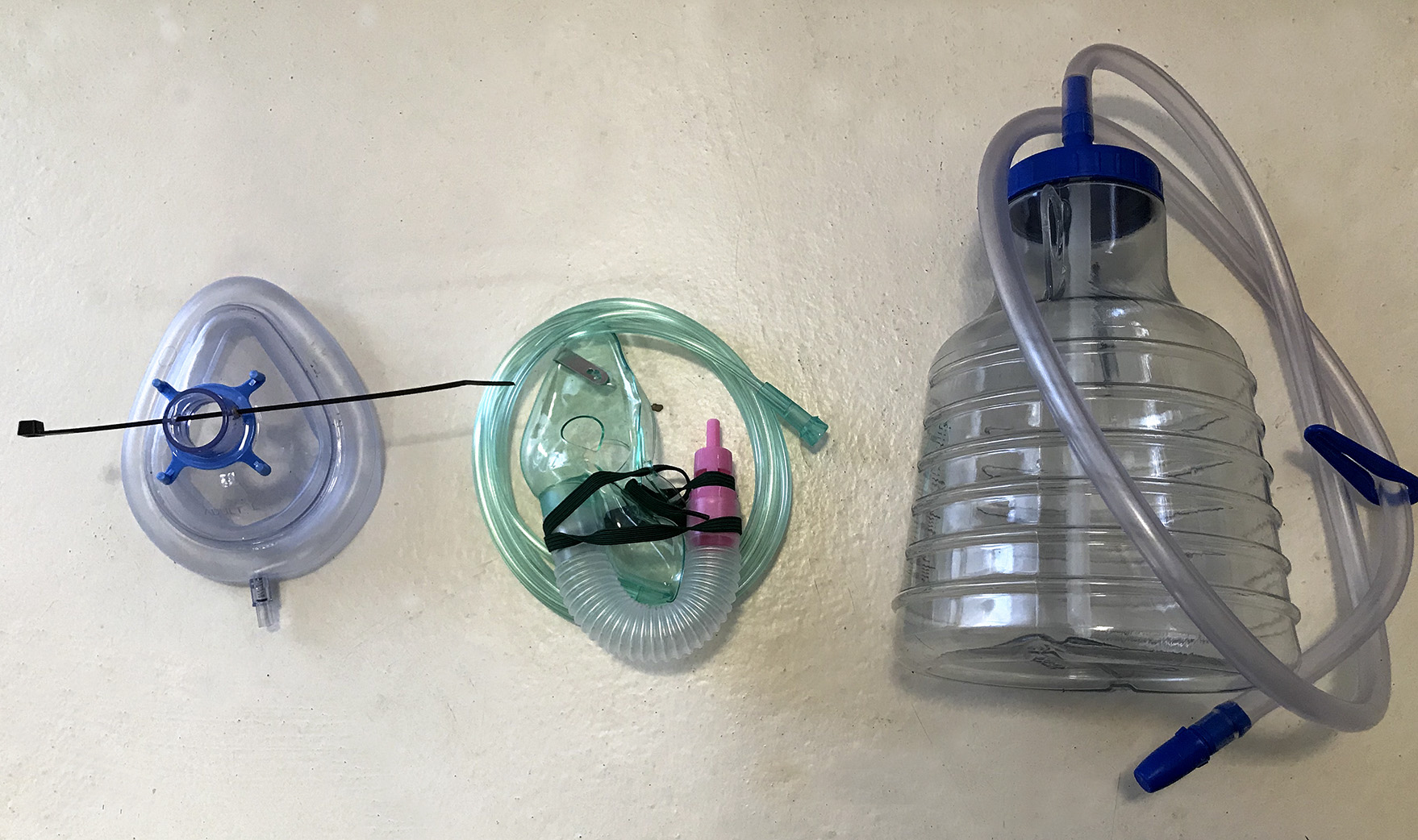SPOTLIGHT EASTERN CAPE
Innovating and adapting at the rural Zithulele Hospital during Covid-19

With chronic health-worker shortages and limited resources such as ventilators in rural public health facilities, how did Zithulele Hospital in OR Tambo district manage its Covid-19 cases? We spoke to two doctors working at Zithulele about an innovative oxygen solution, infection control and much more.
Dr Hans Hendriks, a family physician, and Dr Ben Gaunt, the clinical manager at Zithulele Hospital, are relieved that the worst of the Covid-19 pandemic is seemingly over and they are happy that their hospital managed to cope and save lives.
Zithulele Hospital in Mqanduli, a rural part of the OR Tambo district in the Eastern Cape, is a 146-bed public health facility that serves about 130 000 people. Like many rural health facilities, the hospital had to steer its way through the global pandemic with limited resources.
Speaking to Spotlight about this experience, Hendriks says it was interesting as well as challenging.
“The worst is over now, and we are happy that the cases didn’t go as it was anticipated,” he says. “If it had gone that way, we wouldn’t have been able to cope.”
Hendriks says in some rural areas they expected to admit about 100 Covid-19 patients a day. He says they also thought there would be mass graves.
“But we didn’t see that. As the days progressed, we realised that it was not that bad. It was not the end of the world. We can do this,” he says.
Making do
Gaunt says they had to make do with what they had, and he is glad that it worked.
“We had a ward that was dedicated for drug-resistant tuberculosis patients. With TB cases going down over the past four years, which is very wonderful, we continued the care of the few remaining patients from their homes,” he says. “We changed that ward into a Covid-19 ward to deal with the influx. We had enough space, and we worked around what we had to create capacity.”
Gaunt says renovations by the Department of Public Works also helped.
“We are happy that the numbers didn’t get out of hand because I’m sure the hospital would have been overwhelmed,” says Gaunt.
Hendriks agrees.
“We had to make infrastructure changes. We had to ensure good infection control in [the] casualty and adult wards. For the first few months into the pandemic, there were limited PPE. We never ran out, thanks to some donations, but we had to be careful to allocate what we had where it was needed the most. Some people didn’t understand that different areas (in the hospital) had different PPE requirements. We had to explain to other staff members why they are not getting the same PPE others had. We worked together. Nobody went on leave [and] we made big changes so that we can cope,” Hendriks explains.
Zithulele Hospital was spared water supply and power cuts, something that cannot be taken for granted in many rural areas.
“The hospital has a backup generator that can continue the electricity supply when the power fails,” says Hendriks. He says water was not a problem during the lockdown, but they had to communicate with Eskom and remind the power utility that the hospital was a high-priority area.
“We used thousands of rands worth of diesel running that generator. I have a small solar-power, back-up system at my house to run some lights and charge phones/computers, but not many of us have that available, making power-outs very debilitating for the professional team,” says Hendriks.
Repurposing equipment
With limited ventilators in the country and fears of a shortage, access to ventilators was also a problem at Zithulele Hospital. However, for those in need of respiratory support, hospital staff managed with high-flow nasal oxygen and Continuous Positive Airway Pressure (CPAP) on the most critical patients.
Hendriks says they have had 244 Covid-19 admissions so far. According to him, the hospital has a “fair number” of staff.
“With very few high-care beds and equipment for ventilation, we had to think of ways to help the patients with their breathing.”
To this end, they used Bubble CPAP on patients with the more severe breathing problems, he explains.
“CPAP has been used for a very long time in the paediatric wards for children with infant respiratory distress syndrome. Government has rolled out special machines for use in neonates across the country. With high-flow machines initially delayed due to procurement issues, we had to see what equipment we had at the hospital and work with it to save patients,” Hendriks says. So they used adapted Bubble CPAP for adult Covid-19 patients.

The Bubble CPAP doctors at Zithulele Hospital used to treat Covid-19 patients. (Photo supplied)
How the Bubble CPAP works
A Bubble CPAP is a bedside device that is used for gently blowing air into the upper airway and keeps it open.
The improvised Bubble CPAP comprises a mask from a bag-valve-mask, oxygen tubing connected to wall oxygen, a reservoir from a non-rebreather mask and an underwater intercostal drain set.
“Bubble CPAP relies on the flow of air to create pressure in the airways as the patient breathes in’ and also as they breathe out. The ‘bubble” part’ is the air being exhaled through a water reservoir. It reduces the work of breathing and improves oxygen concentrations. In many cases, it can help avoid the need for mechanical ventilation,” he says.
“We used the piping from an oxygen mask, an intercostal drain bottle and an anaesthetic mask to build the ‘bush-CPAP’ device, including duct tape and a cable-tie. The device works the same for kids and adults, fitting it over the mouth and nose with a seal, providing a mix of air and oxygen at a slight pressure. We made them (CPAPs) as we went along, and the device could be cleaned or sterilised and reused. We probably made about 10 so far,” says Hendriks, explaining that the water in the reservoir could be added from a tap and did not need to be sterile.
“We have treated water at the hospital and it wasn’t much of a problem.”
According to a case report Hendriks authored with other health experts in the African Journal of Emergency Medicine, “the intention of the apparatus was to provide 100% oxygen at adequate flow on inspiration through a tightly sealed facemask while providing positive end-expiratory pressure by forcing expiration through an underwater valve”.
The CPAP was only removed during meals and for oral medication, which resulted in a marked drop in oxygen saturation.
Hendriks is happy that the improvised Bubble CPAP saved lives.
One of their proud achievements was the recovery of their longest-admitted patient who spent 41 days at the hospital. For 10 of those days, the patient was on the Bubble CPAP.
“He fully recovered and was sent home. We have no doubt that he was helped by it (CPAP). With a critical shortage of ventilators, this really helped our patients. The CPAP was used for patients who had mild-to-moderate symptoms but needed a little help to breathe. Then the ventilator [could be] reserved for those with severe symptoms,” Hendriks says.
Bubble CPAP vs ventilator
With a ventilator, the machine takes over the breathing for the patient while a Bubble CPAP supplies a continuous, pressurized airflow and patients still breathe for themselves.
Gaunt says looking at what was happening in other countries, they did not want to put a lot of patients on ventilators.
“The outcomes for ventilated patients were very poor in other countries. It became clear that ventilation was not a good idea. The big question was now how do you support the patient’s breathing and we used the CPAP. Not many people needed ventilation and CPAP was really working. Though we celebrated every patient that was discharged, seeing one of our longest patients, who also spent days on a Bubble CPAP, go home was such a proud moment,” he says.
Using a Bubble CPAP comes with its own advantages. Hendriks says CPAP is non-invasive, much cheaper, more available and much easier to use.
“On top of that, there is less risk of damage compared to ventilation. And if it fails, one can escalate to ventilation. It is commonly seen as the oxygenation-support treatment of choice that is tried first before you intubate and ventilate.”
Managing fear
Gaunt and Hendriks agree that their biggest test was not Covid-19 itself, but managing fear from staff.
“The biggest issue was the staff’s mental health,” says Hendriks. “Covid-19 was not bad. Some staff members were very scared. Others didn’t pitch for work, and that increased the workload for those that were there. We must add that the team at the hospital is very solid. Though some issues at the beginning of the pandemic caused friction, we sorted it out. As we went over the hurdle of fear, we realised we can actually do this. It is not as bad as we thought,” he says.
Gaunt agrees.
“Fear was really a huge challenge. We have staff with comorbidities, so they were worried about their personal safety and that of their colleagues. Others feared getting the virus at the hospital and taking it back to their families. As this virus was new, most people had little or no understanding of it. We all had to learn as we went along, and we did well. I think the worst is over. We might have surges here and there, but it seems highly unlikely to be as bad as the first wave,” he says.
Hendriks applauds the 20 nurses hired on contract to help with Covid-19 patients.
“They were new, with no experience. They had to be taught and trained at work. To see them rise to the challenge and take on this job at such a time was really great. Funnily enough, it was more of the old staff members that struggled to adapt as they were used to doing things a certain way.”
Lessons learnt
Gaunt says going forward they have to find effective ways to engage staff around fear, but he is hopeful they will look back and see the pandemic as something that ultimately brought the team together, despite the difficulties faced.
Hendriks says one aspect that made it easy for them to manage Covid-19 was the fact that their hospital is in the deep rural area.
“One would think twice before coming to the hospital. People would come here when they are really sick. Distance filters people that come to the hospital. Yet, I would imagine in urban areas it was difficult to manage people as they would want to come to the hospital to see their family members, which made it difficult as hospitals didn’t want a lot of people to avoid the spread of the virus,” he says. DM/MC
*This article was published by Spotlight – health journalism in the public interest. Sign up for our newsletter.
"Information pertaining to Covid-19, vaccines, how to control the spread of the virus and potential treatments is ever-changing. Under the South African Disaster Management Act Regulation 11(5)(c) it is prohibited to publish information through any medium with the intention to deceive people on government measures to address COVID-19. We are therefore disabling the comment section on this article in order to protect both the commenting member and ourselves from potential liability. Should you have additional information that you think we should know, please email [email protected]"




 Become an Insider
Become an Insider